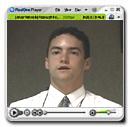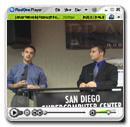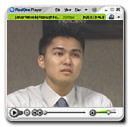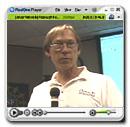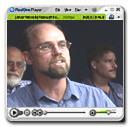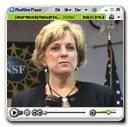UCSD Undergraduates Showcase Research Findings From Cyber Infrastructure Projects in Asia, Australia
October 14, 2004 / By Doug Ramsey
San Diego, 10.14.04 -- Eight students participating in UCSD's inaugural Pacific Rim Undergraduate Experiences (PRIME) program recently presented the results of their research projects, and talked about the value of the experience to undergraduates in science, engineering and other disciplines at UCSD. The undergraduates - all enrolled in the Jacobs School - worked specifically on research projects related to the development and deployment of cyberinfrastructure on both sides of the Pacific Ocean. The PRIME program is funded by the National Science Foundation, with additional support from UCSD and the California Institute for Telecommunications and Information Technology [Calit²].
|
|||||||||
Three students performed research at the School of Computer Science and Engineering at Monash University in Melbourne, Australia. Bioengineering's John Colby, together with CSE's Christopher Kondrick and Duy Nguyen, worked under the direction of David Abramson, a well-respected researcher in software for cyberinfrastructure and a developer of Nimrod/G in Melbourne.
Colby, a Revelle College student also majoring in premedical molecular biology, employed Nimrod and Continuity to study the impact of temporal and spatial distribution of two pacemakers around the heart to understand therapeutic optimizations. Nguyen, who is the first member of his family to attend college, helped incorporate a Rocks cluster, NIMROD, and GAMESS into a ready system for scientific data computing. And Kondrick worked on modifying the NIMROD infrastructure to work with two computational chemistry codes, GAMESS and APBS, to carry out high-throughput chemistry calculations. Apart from Abramson, the students were also mentored by UCSD Bioengineering vice-chair Andrew McCulloch, and two scientists from the San Diego Supercomputer Center: Kim Baldridge, its director of Integrated Computational Sciences; and Philip Papadopoulos, SDSC's program manager for Grid and Cluster Computing, as well as co-principal investigator on the PRAGMA award.
|
||||||
Three of the UCSD students worked in Osaka, Japan with professor Shinji Shimojo, vice-director of the Cybermedia Center at Osaka University. Shimojo is a world-renowned scientist who is the principal investigator on a major award to build a Biogrid in Japan. Assisting in the collaborative efforts from Osaka University was Susumu Date, an assistant professor in the Graduate School of Information Science and Technology. Takumi Takahashi, a pre-med Bioengineering major, worked with Date and Shimojo and UCSD Bioengineering chair Shu Chien to adapt tools to integrate data from different genomic databases relevant to cell function.
Ramsin Khoshabeh, an Electrical and Computer Engineering (ECE) student, worked together with MAE major Stephen Geist to explore the next-generation IPv6 protocol with respect to key components of the telescience infrastructure, with Geist concentrating on migrating code from a camera at UCSD's National Center for Microscopy and Imaging Research (NCMIR) to the same camera on the Osaka microscope. Khoshabeh and Geist worked with professors Shimojo and Toyokazu Akiyama in Osaka, as well as a team of UCSD mentors including neuroscientist Mark Ellisman (director of both NCMIR and the Center for Research in Biological Structure), NCMIR's executive director Steve Peltier, and center researcher Tomas Molina.
|
||||||
Robert Ikeda and Brandon Smith spent the summer in Taiwan, at the National Center for High-performance Computing (NCHC) in Hsinchu, Taiwan, under the guidance of its Grid Computing Division manager Fang-Pang Lin, and Bioengineering assistant professor Trey Ideker at UCSD. They were working to develop large-scale, computer-aided models of biological signaling and regulatory pathways. ECE's Ikeda pursued the development of a graphical user interface for pathway editing and integration in Cytoscape, while Computer Science and Engineering (CSE) undergrad Smith helped install a wireless network while extending the Ecogrid in Taiwan's Ecological Parks. Smith also worked on enhancing software of the Collaborative Lake Metabolism Project. Smith was mentored by Lin, Arzberger, and Tony Fountain, who directs the Knowledge and Information Discovery Lab within the Data and Knowledge Systems program of the San Diego Supercomputer Center (SDSC).
Jared Bell, a Revelle College undergraduate who expects to earn his Bachelor of Science in structural engineering in June of 2005, also spent the summer in Taiwan. His focus: Internet-based virtual laboratory testing for earthquake resistance of structures using the National Earthquake Engineering Simulation (NEES) model. He worked for Keh-Chyuan Tsai, director of Taiwan's National Center for Research on Earthquake Engineering; NCHC's Fang-Pang Lin; and Chia-Ming Uang, professor and vice-chair of UCSD's Structural Engineering department.
|
|||||||||
The program's project coordinators at UCSD were Sixth College Provost Gabriele Wienhausen, principal investigator on the PRIME project; Linda Feldman, director of UCSD's Academic Internship Program; and Peter Arzberger, director of the Life Sciences Initiative at UCSD, director of the National Biomedical Computation Resource (NBCR), and principal investigator on the Pacific Rim Applications and Grid Middleware Assembly (PRAGMA). The students unveiled their research presentations during the PRAGMA 7 Workshop which took place in mid-September at the San Diego Supercomputer Center.
PRIME students are required to be U.S. citizens or permanent residents, and must be enrolled as full-time students at UCSD with a minimum GPA of 3.0 (out of 4.0). Students are expected to submit papers on their experiences abroad and present papers at the UCSD undergraduate research conference. Sites in 2004 were in Australia, Japan and Taiwan, but program administrators are now talking with research institutions in other Asian countries, notably Thailand, to host future groups of UCSD researchers.
# # #
RELATED MULTIMEDIA :
Video Showcase
John Colby
Christopher Kondrick
Duy Nguyen
Ramsin Khoshabeh and Stephen Geist
Takumi Takahashi
Jared Bell
Robert Ikeda
UCSD Life Sciences Initiative director Peter Arzberger
Bioengineering professor Andrew McCulloch
Academic Internship Program director Linda Feldman
RELATED LINKS:
Pacific Rim Undergraduate Research Experiences (PRIME)
PRAGMA 7 Workshop
UCSD Academic Internship Program
Media Contacts
Doug Ramsey, Jacobs School of Engineering 858-822-5825, dramsey@ucsd.edu


